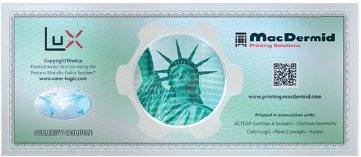Can our premium products, LUX & UVR, affect your purchasing decision? MacDermid conducted a study between a LUX + UVR package, and a standard digital version at the Clemson University consumer experience lab to answer this question. Here’s some of what he heard from survey participants:
- 79% noticed a difference in print quality
- 66% stated that the LUX + UVR package appeared newer and more fresh
- 75% would purchase the LUX + UVR package over the alternative

TECHNOLOGY COLLABORATION DEMONSTRATES FLEXO ADVANCEMENTS
In advance of LabelExpo Europe 2013 in Brussels, Belgium, MacDermid, along with five other industry suppliers, collaborated to demonstrate that flexography is competitive with printing processes that are widely perceived to be of higher quality. MacDermid used its latest printing plate designed exclusively for UV inks in the narrow web market, UVR, and applied LUX Membrane 100 to the plate.

The project produced two print versions — one on metallic substrate and another using metallic ink on conventional paper — of six nearly identical images that clearly show the outstanding quality available with flexography.
The Design was done by the Color-Logic Brand Services Division, using the Color-Logic Design Suite to produce a complex, currency-like image in label format. The image contains a number of challenging elements, including scrollwork, microprinting, metallics, QR codes, and process colors.
The Press chosen for the collaboration image was an Omet Varyflex at Clemson University, running at 125 feet per minute (38 meters per minute). Avery Dennison SILV/AT20/40#S metallic and UPM Raflatac Cast Gloss RH09 2.5 mil White Kraft paper substrates were used.
The Plates were MacDermid UVR 0.067 Solvent plates, incorporating the MacDermid LUX Membrane 100 flat-top dot technology.
The Anilox Rolls, supplied by Harper, included Platinum XLT-60° Anilox Rolls at 1200 cells per inch (475 cells per centimeter) and 1.8 BCM for the process inks, 120 cells per inch (47 cells per centimeter) and 12 BCM for the metallic ink, 500 cells per inch (197 cells per centimeter) and 5 BCM for the white and matte overprint varnish, and 30 cells per inch (12 cells per centimeter) and 15 BCM for the tactile coating.
The Doctor Blade used was a Flexo Concepts TruPoint Orange polymer blade with advanced MicroTip Technology.
The Inks and Coatings, furnished by ACTEGA WIT, included Pharmaflex Signature inks, Pure Flex Silver ink, Rad-Kote Matte varnish, and Tactile Coat coating.
Comments from the Collaborators
Color-Logic designed the images to showcase metallic printing and take advantage of the quality which flexo can produce. Color-Logic Director of Sales and Marketing Mark Geeves: “The Color-Logic Design Suite enables graphic designers to create complex designs, metallics, and special effects at a fraction of the time and cost previously required. “
Info at www.color-logic.com
Harper anilox rolls were used on the project. Harper Graphic Solutions Director Alexander James: “This project was designed to show that flexography can compete for the high-end quality work required on labels and packaging today. The combined resources of the collaborators provide a real world example of what flexo can do in the marketplace.”
Info at www.harperimage.com
Clemson University printed the images on an Omet Varyflex press in their Sonoco Institute of Package Design and Graphics. Clemson Research Associate Brad Gasque: “Clemson University constantly seeks to collaborate with companies that are pushing the limits of flexography in labels and packaging.”
Info at www.clemson.edu/sonoco_institute
Flexo Concepts provided the latest in doctor blade technology for the project. Flexo Concepts Marketing Manager Ken Theriot: “This project let us demonstrate the quality achievable with TruPoint Orange and its MicroTip Technology. Our doctor blade advancements help flexography compete in highly demanding applications while eliminating anilox scoring, improving pressroom safety, extending blade life and lastly, by curing UV ink spitting, which is often seen in high line screen and specialty process work.”
Info at www.flexoconcepts.com.
MacDermid Printing Solutions provided the flexo plates for the collaboration.
MacDermid Director of Marketing Heather Barrett: “Our new MacDermid UVR plate is designed to swell less with UV inks, while offering excellent print resolution and low dot gain. The project also incorporated the MacDermid LUX flat dot solution, which is widely accepted for flexible packaging and other difficult applications. The project for Labelexpo Europe 2013 involved difficult images and the results were outstanding!”
Info at printing.macdermid.com
ACTEGA WIT provided inks and coatings for the project. ACTEGA
WIT Marketing Manager Carmen Wagner: “Our inks and coatings are extremely well suited for complex images and substrates such as those used on this project. ACTEGA WIT is proud to have participated in this groundbreaking project.”
Info at www.actega.com/wit
